Related Research Articles
In the broader context of racism against Black Americans and racism in the United States, mass racial violence in the United States consists of ethnic conflicts and race riots, along with such events as:

The Tulsa race massacre, also known as the Tulsa race riot or the Black Wall Street massacre, was a two-day-long massacre that took place between May 31 – June 1, 1921, when mobs of white residents, some of whom had been appointed as deputies and armed by city government officials, attacked black residents and destroyed homes and businesses of the Greenwood District in Tulsa, Oklahoma. The event is considered one of "the single worst incident[s] of racial violence in American history" and has been described as one of the deadliest terrorist attacks in the history of the United States. The attackers burned and destroyed more than 35 square blocks of the neighborhood—at the time one of the wealthiest black communities in the United States, colloquially known as "Black Wall Street."

Danville is an independent city in the Commonwealth of Virginia in the United States, located in the Southside Virginia region and on the fall line of the Dan River. It was a center of tobacco production and was an area of Confederate activity during the American Civil War, due to its strategic location on the Richmond and Danville Railroad. In April 1865 it briefly served as the final capital of the Confederacy before the South surrendered.
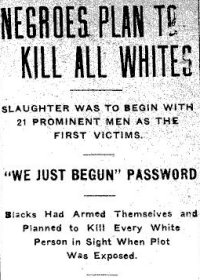
The Elaine massacre occurred on September 30–October 2, 1919 at Hoop Spur in the vicinity of Elaine in rural Phillips County, Arkansas. As many as several hundred African Americans and five white men were killed. Estimates of deaths made in the immediate aftermath of the Elaine Massacre by eyewitnesses range from 50 to "more than a hundred". Walter Francis White, an NAACP attorney who visited Elaine shortly after the incident, stated "... twenty-five Negroes killed, although some place the Negro fatalities as high as one hundred". More recent estimates in the 21st century of the number of black people killed during this violence are higher than estimates provided by the eyewitnesses, and have ranged into the hundreds. Robert Whitaker estimated 856 people were killed in his 2008 book on this topic. The white mobs were aided by federal troops and terrorist organizations such as the newly revived Ku Klux Klan. Gov. Brough led a contingent of 583 US soldiers from Camp Pike, with a 12-gun machine gun battalion.
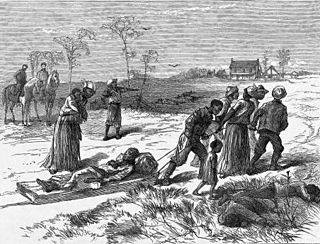
The Colfax massacre, referred to sometimes as the Colfax riot, occurred on Easter Sunday, April 13, 1873, in Colfax, Louisiana, the parish seat of Grant Parish. An estimated 62–153 black militia men were murdered while surrendering to a mob of former Confederate soldiers and members of the Ku Klux Klan. Three white men also died during the confrontation.

The Readjuster Party was a bi-racial state-level political party formed in Virginia across party lines in the late 1870s during the turbulent period following the Reconstruction era that sought to reduce outstanding debt owed by the state. Readjusters aspired "to break the power of wealth and established privilege" among the planter elite of white men in the state and to promote public education. The party's program attracted support among both white people and African-Americans.
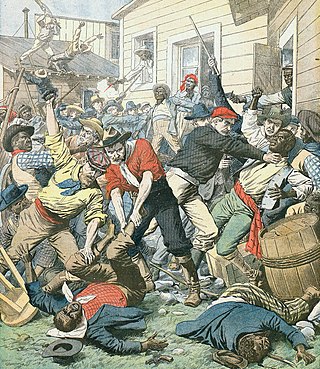
Red Summer was a period in mid-1919 during which white supremacist terrorism and racial riots occurred in more than three dozen cities across the United States, and in one rural county in Arkansas. The term "Red Summer" was coined by civil rights activist and author James Weldon Johnson, who had been employed as a field secretary by the National Association for the Advancement of Colored People (NAACP) since 1916. In 1919, he organized peaceful protests against the racial violence.

The Marrow of Tradition (1901) is a novel by the African-American author Charles W. Chesnutt, portraying a fictional account of the Wilmington Insurrection of 1898 in Wilmington, North Carolina, an event that had just recently occurred.
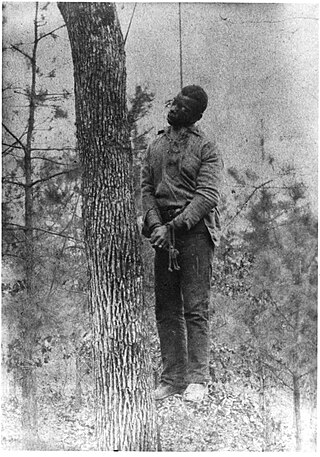
Lynching was the widespread occurrence of extrajudicial killings which began in the United States' pre–Civil War South in the 1830s and ended during the civil rights movement in the 1950s and 1960s. Although the victims of lynchings were members of various ethnicities, after roughly 4 million enslaved African Americans were emancipated, they became the primary targets of white Southerners. Lynchings in the U.S. reached their height from the 1890s to the 1920s, and they primarily victimised ethnic minorities. Most of the lynchings occurred in the American South because the majority of African Americans lived there, but racially motivated lynchings also occurred in the Midwest and border states.

Harrison Holt Riddleberger was a Virginia lawyer, newspaper editor and politician from Shenandoah County. A Confederate States Army officer who at various times aligned with the Conservative Party of Virginia, the Readjuster Party and the Democratic Party, Riddleberger served in both houses of the Virginia General Assembly, which elected him for one term as U.S. Senator.

The Hamburg Massacre was a riot in the American town of Hamburg, South Carolina, in July 1876, leading up to the last election season of the Reconstruction Era. It was the first of a series of civil disturbances planned and carried out by white Democrats in the majority-black Republican Edgefield District, with the goal of suppressing black Americans' civil rights and voting rights and disrupting Republican meetings, through actual and threatened violence.
Domestic terrorism in the United States consists of incidents which are confirmed to be domestic terrorist acts. These attacks are considered domestic because they occurred within the United States and they were carried out by U.S. citizens and/or U.S. permanent residents. As of 2021, the United States government considers white supremacists to be the top domestic terrorism threat.

The Wilmington insurrection of 1898, also known as the Wilmington massacre of 1898 or the Wilmington coup of 1898, was a coup d'état and massacre carried out by white supremacists in Wilmington, North Carolina, United States, on Thursday, November 10, 1898. The white press in Wilmington originally described the event as a race riot caused by black people. Since the late 20th century and further study, the event has been characterized as a violent overthrow of a duly elected government by a group of white supremacists. It is the only such incident in the history of the United States.

Leonidas Carstarphen Dyer was an American politician, reformer, civil rights activist, and military officer. A Republican, he served eleven terms in the U.S. Congress as a U.S. Representative from Missouri from 1911 to 1933. In 1898, enrolling in the U.S. Army as a private, Dyer served notably in the Spanish–American War; and was promoted to colonel at the war's end.
This is a list of topics related to racism:
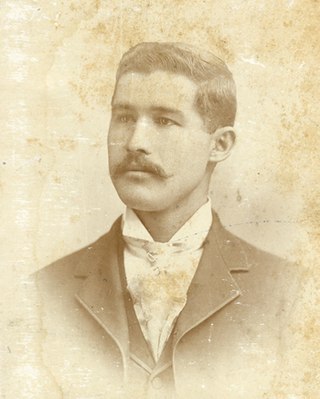
AlexanderLightfoot Manly was an newspaper owner and editor who lived in Wilmington, North Carolina. With his brother, Frank G. Manly, as co-owner, he published the Daily Record, the state's only daily African-American newspaper and possibly the nation's only black-owned daily newspaper. At the time, the port of Wilmington had 10,000 residents and was the state's largest city; its population was majority black, with a rising middle class.
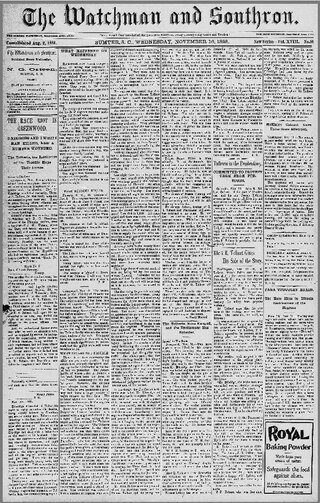
The Phoenix election riot occurred on November 8, 1898, near Greenwood County, South Carolina, when a group of local white Democrats attempted to stop a Republican election official from taking the affidavits of African Americans who had been denied the ability to vote. The race-based riot was part of numerous efforts by white conservative Democrats to suppress voting by blacks, as they had largely supported the Republican Party since the Reconstruction era. Beginning with Mississippi in 1890, and South Carolina in 1895, southern states were passing new constitutions and laws designed to disenfranchise blacks by making voter registration and voting more difficult.
The Ocoee massacre was a mass racial violence event that saw a white mob attack numerous African-American residents in the northern parts of Ocoee, Florida, a town located in Orange County near Orlando. The massacre took place on November 2, 1920, the day of the U.S. presidential election.
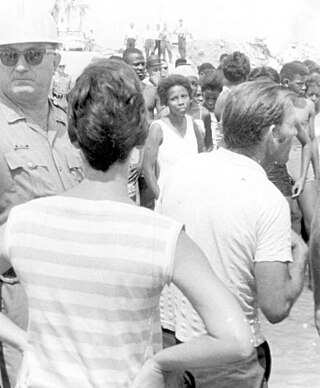
In the context of racism in the United States, racism against African Americans dates back to the colonial era, and it continues to be a persistent issue in American society in the 21st century.
References
- ↑ "Group One Materials". Danville Museum of Fine Arts and History.
- ↑ "Inquiry into Massacre of Colored Men at Danville, Va., and Alleged Election Outrages in Virginia, in 1883: hearings before the United States Senate Committee on Privileges and Elections, Forty-Eighth Congress, first session, on Feb. 14, 15, 18–21, 25–27, Mar. 4, 5, 10, 11, 27–29, 31, Apr. 1–5, 7, 14, 15, 1884". U.S. G.P.O. October 30, 1884 – via Berkeley Law.
- 1 2 3 4 Wolfe, Brendan (2015). "Danville Riot (1883)". Encyclopedia Virginia. Virginia Humanities.
- ↑ Bailey, Frankie Y.; Green, Alice P. (2011). Wicked Danville: Liquor and Lawlessness in a Southside Virginia City. Arcadia Publishing Incorporated. p. 59. ISBN 978-1-62584-122-3.
- ↑ ""The Danville Massacre," New York Times (November 10, 1883)".
- 1 2 "The Press on the Danville Riot". Richmond Dispatch . November 6, 1883. Archived from the original on February 25, 2019. Retrieved February 25, 2019.
- 1 2 Pottiger, Maya (October 19, 2021). "In the 1880s, election fraud and a massacre stopped Black progress". Word In Black.
- ↑ Brent Tarter, "Post-Reconstruction Suffrage and following sections", Disfranchisement, Encyclopedia of Virginia, 19 July 2016; accessed 17 March 2018
- ↑ Lynching in America, 2nd edition Archived 2018-06-27 at the Wayback Machine , Supplement by County, p. 7